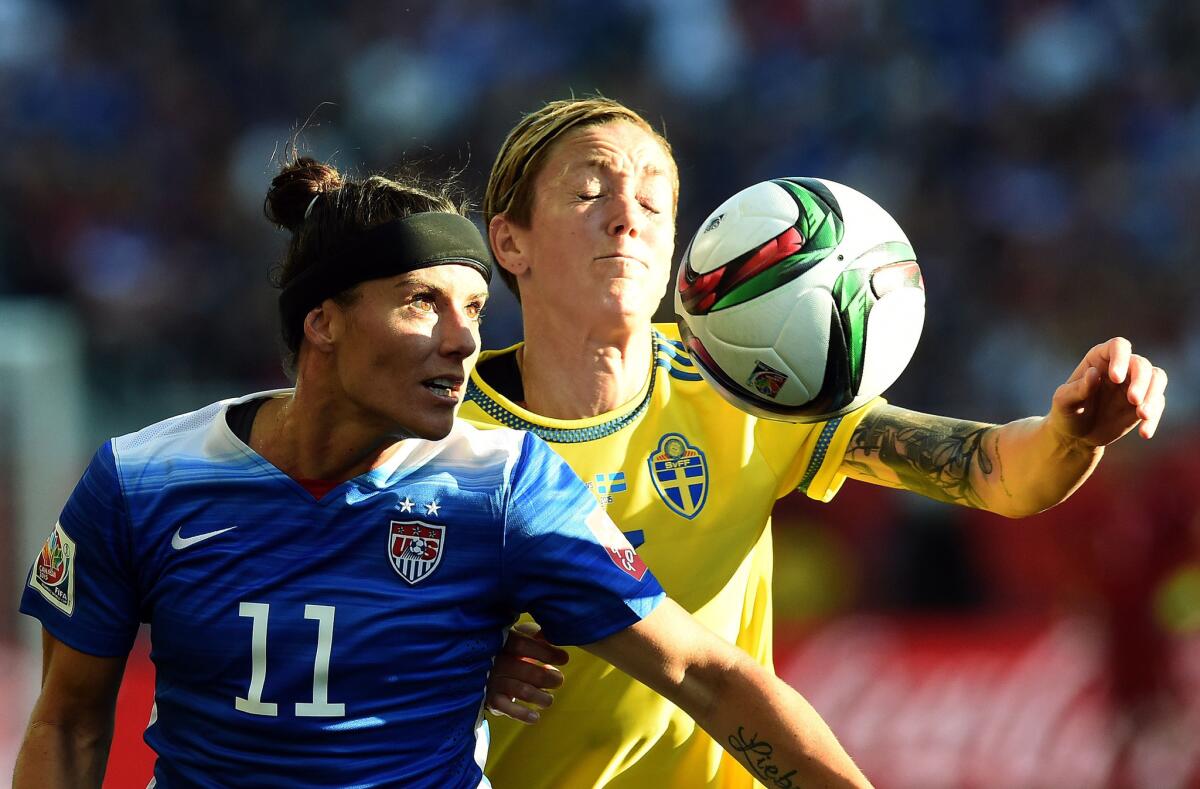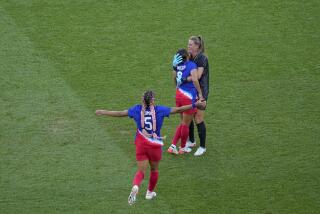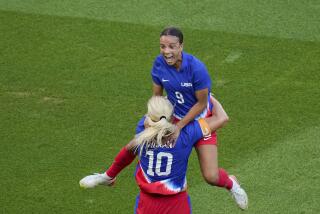U.S. team points to artificial turf for offensive woes at World Cup

U.S. defender Ali Krieger and Sweden midfielder Therese Sjogran battle for possession of the ball during the first half of their group game on Friday at the Women’s World Cup.
- Share via
Reporting from Vancouver, Canada — Finally, an explanation for the U.S. team’s offensive struggles at the women’s World Cup: It’s the artificial turf.
In the team’s opening game, a 3-1 win over Australia, Abby Wambach mishit two headers that went wide. And in Friday’s scoreless tie with Sweden, Wambach’s diving header off the turf was deflected over the crossbar by goalkeeper Hedvig Lindahl.
“I score if we’re on grass,” Wambach said after the U.S. relocated from Winnipeg to Vancouver for Tuesday’s group-play final with Nigeria. “The ball, as it comes off my head against Sweden, hits a dry turf and bounces higher. If it hits grass, it’s harder for a goalkeeper to react.”
Against Australia, the abrasive surface had Wambach thinking before diving.
“I don’t completely lay out and commit to those headers and that’s why they glance off my head rather than me contacting them,” she said Saturday. “I definitely think that the United States has more goals if we’re playing on grass.”
Wambach led a coalition of more than 60 top players in challenging FIFA’s decision to make this tournament the first World Cup played solely on artificial turf. That challenge, in front of the Ontario Human Rights Tribunal, was dropped in January.
But one of the arguments in the complaint was that soccer is played differently on artificial turf. And both Wambach and the lawsuit may have a point since scoring is way down in this World Cup.
Take away Germany’s 10-0 victory over Ivory Coast and two losses in which Ecuador gave up 16 goals, and there have been only 2.24 goals per game in the tournament. That’s down nearly half a goal from four years ago.
Two games have ended scoreless, the first since 2007, and six have produced only one goal.
But former U.S. coach Pia Sundhage, now coach of Sweden, credits parity for the change.
“The gap between the best team and the worse team is getting closer and closer,” she said. “Nowadays it’s not just ‘go for goals.’ Twelve years back … we’ve got to show everybody we’re a good team and we’re so much better than the opponents. That is not the case today. You have to be more careful with the game plan.”
The U.S. was shut out twice in six games on grass before getting to Canada. In the last of those, a scoreless tie with South Korea in Harrison, N.J., the U.S. failed to score at home for the first time since 2008. And the five shutouts the Americans have endured since December tie for the most in a 13-game span in 26 years.
U.S. forwards have scored as many goals (six) in the last eight games as have the team’s defenders.
“I don’t think it was as efficient as we needed it to be,” Coach Jill Ellis said of her latest lineup, which partnered Sydney Leroux with Christen Press up front against Sweden. “In terms of quality looks and quality chances, I think we could have been better and more productive out of the two of them.”
So against Nigeria, a team the U.S. must beat to win the group and assure itself of an easier route through the knockout stages, there probably will be more changes, with Alex Morgan or Amy Rodriguez likely to get her first start of the tournament.
Wambach believes that making adjustments is utterly important.
“Championship teams are the teams that are able to deal with all things, in all moments, in all sorts of ways,” Wambach said.









